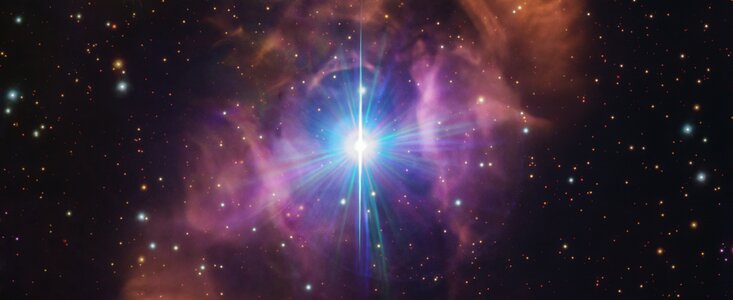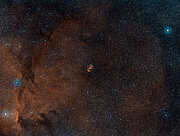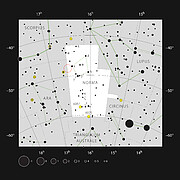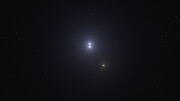Tisková zpráva
Krásná mlhovina s bouřlivou historií: srážka hvězd osvětluje hvězdnou záhadu
11. dubna 2024

Při pohledu na hvězdný pár v srdci úchvatného oblaku plynu a prachu astronomy čekalo překvapení. Hvězdné páry jsou si obvykle velmi podobné, jako dvojčata, ale v případě HD 148937 se jedna hvězda zdá být mladší a na rozdíl od druhé je magnetická. Nová data Evropské jižní observatoře (ESO) naznačují, že v systému byly původně hvězdy tři, dokud se dvě z nich nesrazily a nesplynuly. Tato bouřlivá událost vytvořila mrak, který systém obklopuje, a navždy změnila jeho osud.
"Při studiu podkladů mě zaujalo, jak zvláštní se tento systém zdá," říká Abigail Frostová, astronomka z ESO v Chile a hlavní autorka studie, která byla dnes zveřejněna v časopise Science. Systém HD 148937 se nachází asi 3800 světelných let od Země směrem k souhvězdí Normy. Tvoří ho dvě hvězdy mnohem hmotnější než Slunce a obklopuje ho nádherná mlhovina, oblak plynu a prachu. "Mlhovina obklopující dvě masivní hvězdy je raritou, takže jsme tušili, že se v tomto systému stalo něco nevídaného, což se při pohledu na data potvrdilo."
"Po podrobné analýze jsme zjistili, že hmotnější hvězda vypadá mnohem mladší než její souputník, což nedává smysl, protože by měly vzniknout ve stejnou dobu!", říká Frost. Tento věkový rozdíl - jedna hvězda se zdá být nejméně o 1,5 milionu let mladší než druhá - naznačuje, že hmotnější hvězdu muselo něco omladit.
Dalším dílem skládačky je mlhovina obklopující hvězdy, známá jako NGC 6164/6165. Je stará 7500 let, tedy několiksetkrát mladší než obě hvězdy, a obsahuje vysoké množství dusíku, uhlíku a kyslíku. To je překvapivé, protože tyto prvky se obvykle nachází hluboko uvnitř hvězdy, nikoliv vně; jako by je snad uvolnila nějaká bouřlivá událost.
Aby skupina tuto záhadu rozluštila, shromáždila data naměřená během devíti let přístroji PIONIER a GRAVITY, které jsou umístěny na ESO dalekohledu VLTI (Very Large Telescope Interferometer) v chilské poušti Atacama. Využili také archivní data z přístroje FEROS na ESO observatoři La Silla.
"Domníváme se, že se tento systém původně skládal z nejméně tří hvězd; dvě z nich musely být v určitém bodě dráhy blízko sebe, zatímco další byla mnohem dále," vysvětluje Hugues Sana, profesor na KU Leuven v Belgii a hlavní řešitel pozorování. "Dvě bližší hvězdy se spojily, vytvořily magnetickou hvězdu a vyvrhly část materiálu, který vytvořil mlhovinu. Vzdálenější hvězda se dostala na novou oběžnou dráhu s nově sloučenou, nyní magnetickou hvězdou, čímž vznikla dvojhvězda, kterou dnes vidíme v jádru mlhoviny."
"Toto vysvětlení - splynutí dvou hvězd - jsem měl v hlavě už v roce 2017, když jsem studoval pozorování mlhoviny získaná pomocí Herschelova vesmírného dalekohledu Evropské vesmírné agentury," dodává spoluautor Laurent Mahy, který v současnosti působí jako seniorní výzkumný pracovník na belgické Královské observatoři (Royal Observatory of Belgium). "Rozdíl ve stáří hvězd naznačoval, že tento scénář je nejpravděpodobnější, ale důkaz poskytla až nová data z ESO."
Teorie také vysvětluje, proč je jedna z hvězd v systému magnetická a druhá ne, což je další zvláštnost HD 148937 zaznamenaná v datech VLTI.
Zároveň pomáhá objasnit dlouholetou záhadu v astronomii: jak masivní hvězdy získávají svá magnetická pole. Zatímco magnetická pole jsou běžnou vlastností hvězd s nízkou hmotností, jako je naše Slunce, hmotnější hvězdy si magnetické pole stejným způsobem udržet nemohou. Přesto ale takové hvězdy nacházíme.
Astronomové již delší dobu předpokládali, že masivní hvězdy mohou získat magnetické pole při splynutí dvou hvězd. Vědci však poprvé nalezli přímý důkaz, že se tak děje. V případě HD 148937 muselo ke splynutí dojít nedávno. "Předpokládá se, že magnetismus u masivních hvězd netrvá příliš dlouho v porovnání s jejich dobou života, takže se zdá, že jsme tuto vzácnou událost pozorovali velmi brzy poté, co k ní došlo," dodává Frost.
ESO dalekohled ELT (Extremely Large Telescope), který se v současné době staví v chilské poušti Atacama, umožní vědcům podrobněji zjistit, co se v soustavě stalo, a možná přinese i další překvapení.
Další informace
Tento výzkum byl prezentován v článku s názvem "A magnetic massive star has experienced a stellar merger", který vyjde v časopise Science (www.science.org/doi/10.1126/science.adg7700). Článek vyjde v tištěné podobě v časopise Science v pátek 12. dubna 2024 a online bude zveřejněn ve čtvrtek 11. dubna 2024 ve 14:00 východoamerického času (20:00 SELČ). Finální verzi článku, na který bylo uvaleno embargo, najdete na adrese https://www.eurekalert.org/press/scipak/ nebo na adrese scipak@aaas.org, dokud embargo trvá.
Projekt byl financován Evropskou radou pro výzkum (ERC) v rámci programu Evropské unie pro výzkum a inovace Horizont 2020 (grantová dohoda číslo 772225: MULTIPLES; hlavní řešitel: Hugues Sana).
Skupinu tvoří A. J. Frost (Evropská jižní observatoř, Santiago, Chile [ESO Chile] a Astronomický ústav KU Leuven, Belgie [KU Leuven]), H. Sana (KU Leuven), L. Mahy (Belgická královská observatoř, Belgie a KU Leuven), G. Wade (Department of Physics & Space Science, Royal Military College of Canada, Kanada [RMC Space Science]), J. Barron (Department of Physics, Engineering & Astronomy, Queen's University, Kanada a RMC Space Science), J.- B. Le Bouquin (Université Grenoble Alpes, Centre national de la Recherche Scientifique, Institute de Planétologie et d'Astrophyisique de Grenoble, Francie), A. Mérand (European Southern Observatory, Garching, Německo [ESO]), F. R. N. Schneider (Heidelberger Institut für Theoretische Studien, Německo a Astronomisches Rechen-Institut, Zentrum für Astronomie der Universität Heidelberg, Německo), T. Shenar (The School of Physics and Astronomy, Tel Aviv University, Izrael a KU Leuven), R. H. Barbá (Departamento de Física y Astronomía, Universidad de La Serena, Chile), D. M. Bowman (School of Mathematics, Statistics and Physics, Newcastle University, Spojené království a KU Leuven), M. Fabry (KU Leuven), A. Farhang (School of Astronomy, Institute for Research in Fundamental Sciences, Írán), P. Marchant (KU Leuven), N. I. Morrell (Las campanas Observatory, Carnegie Observatories, Chile) a J. V. Smoker (ESO Chile a UK Astronomy Technology centre, Royal Observatory, UK).
Evropská jižní observatoř (ESO) umožňuje vědcům z celého světa objevovat tajemství vesmíru ve prospěch všech. Navrhujeme, stavíme a provozujeme pozemní observatoře světové úrovně, které astronomové využívají k řešení vzrušujících záhad vesmíru a šíření fascinace astronomií, a podporujeme mezinárodní spolupráci v oblasti astronomie. ESO bylo založeno jako nadnárodní organizace v roce 1962 a dnes ji podporuje 16 členských států (Belgie, Česká republika, Dánsko, Francie, Finsko, Irsko, Itálie, Německo, Nizozemsko, Polsko, Portugalsko, Rakousko, Spojené království, Španělsko, Švédsko a Švýcarsko), hostitelský stát Chile a Austrálie jako strategický partner. Sídlo ESO a její návštěvnické centrum a planetárium ESO Supernova se nachází nedaleko německého Mnichova, zatímco chilská poušť Atacama, nádherné místo s jedinečnými podmínkami pro pozorování oblohy, je domovem našich dalekohledů. ESO provozuje tři pozorovací stanoviště: La Silla, Paranal a Chajnantor. Na Paranalu provozuje Very Large Telescope a jeho Interferometr, jakož i přehlídkové dalekohledy, jako je VISTA. Na Paranalu bude ESO také hostit a provozovat soustavu Čerenkovových teleskopů (Cherenkov Telescope Array South), největší a nejcitlivější observatoř pro gama záření na světě. ESO společně s mezinárodními partnery provozuje na Chajnantoru observatoř ALMA, která pozoruje oblohu v milimetrovém a submilimetrovém pásmu. Na Cerro Armazones poblíž Paranalu budujeme "největší oko upřené k nebi" - Extremely Large Telescope. Z našich kanceláří v Santiagu v Chile podporujeme naší činnost v zemi a spolupracujeme s chilskými partnery a společností.
Odkazy
- Vědecký článek (preprint; pro finální verzi článku, na který bylo uvaleno embargo, se prosím podívejte na https://www.eurekalert.org/press/scipak/ nebo kontaktujte scipak@aaas.org, dokud embargo trvá)
- Fotografie VLT/VLTI
- Přečtěte si více o ELT na zvláštní stránce a v press kitu
- Pro novináře: přihlašte se k odběru tiskových zpráv v češtině
- Pro vědce: máte pro nás námět? Popularizujte svůj výzkum
Kontakty
Abigail Frost
European Southern Observatory
Santiago, Chile
Tel.: +44 79 8353 9292
Email: Abigail.Frost@eso.org
Hugues Sana
KU Leuven
Leuven, Belgium
Tel.: +32 479 50 46 73
Email: hugues.sana@kuleuven.be
Laurent Mahy
Royal Observatory of Belgium
Brussels, Belgium
Tel.: +32 476 23 60 06
Email: laurent.mahy@oma.be
Bárbara Ferreira
ESO Media Manager
Garching bei München, Germany
Tel.: +49 89 3200 6670
Mobil: +49 151 241 664 00
Email: press@eso.org
Lê Binh San PHAM
Communication Officer, Royal Observatory of Belgium
Brussels, Belgium
Email: lebinhsan.pham@oma.be
Anežka Srbljanović (press contact Česko)
ESO Science Outreach Network
a Astronomical Institute of Czech Academy of Sciences
Tel.: +420 323 620 116
Email: eson-czech@eso.org
O zprávě
| Tiskové zpráva č.: | eso2407cs |
| Jméno: | HD 148937, NGC 6164, NGC 6165 |
| Typ: | Milky Way : Star : Grouping : Binary Milky Way : Nebula |
| Facility: | Very Large Telescope Interferometer |
| Instruments: | FEROS, GRAVITY, PIONIER |
| Science data: | 2024Sci...384..214F |
Our use of Cookies
We use cookies that are essential for accessing our websites and using our services. We also use cookies to analyse, measure and improve our websites’ performance, to enable content sharing via social media and to display media content hosted on third-party platforms.
ESO Cookies Policy
The European Organisation for Astronomical Research in the Southern Hemisphere (ESO) is the pre-eminent intergovernmental science and technology organisation in astronomy. It carries out an ambitious programme focused on the design, construction and operation of powerful ground-based observing facilities for astronomy.
This Cookies Policy is intended to provide clarity by outlining the cookies used on the ESO public websites, their functions, the options you have for controlling them, and the ways you can contact us for additional details.
What are cookies?
Cookies are small pieces of data stored on your device by websites you visit. They serve various purposes, such as remembering login credentials and preferences and enhance your browsing experience.
Categories of cookies we use
Essential cookies (always active): These cookies are strictly necessary for the proper functioning of our website. Without these cookies, the website cannot operate correctly, and certain services, such as logging in or accessing secure areas, may not be available; because they are essential for the website’s operation, they cannot be disabled.
Functional Cookies: These cookies enhance your browsing experience by enabling additional features and personalization, such as remembering your preferences and settings. While not strictly necessary for the website to function, they improve usability and convenience; these cookies are only placed if you provide your consent.
Analytics cookies: These cookies collect information about how visitors interact with our website, such as which pages are visited most often and how users navigate the site. This data helps us improve website performance, optimize content, and enhance the user experience; these cookies are only placed if you provide your consent. We use the following analytics cookies.
Matomo Cookies:
This website uses Matomo (formerly Piwik), an open source software which enables the statistical analysis of website visits. Matomo uses cookies (text files) which are saved on your computer and which allow us to analyze how you use our website. The website user information generated by the cookies will only be saved on the servers of our IT Department. We use this information to analyze www.eso.org visits and to prepare reports on website activities. These data will not be disclosed to third parties.
On behalf of ESO, Matomo will use this information for the purpose of evaluating your use of the website, compiling reports on website activity and providing other services relating to website activity and internet usage.
Matomo cookies settings:
Additional Third-party cookies on ESO websites: some of our pages display content from external providers, e.g. YouTube.
Such third-party services are outside of ESO control and may, at any time, change their terms of service, use of cookies, etc.
YouTube: Some videos on the ESO website are embedded from ESO’s official YouTube channel. We have enabled YouTube’s privacy-enhanced mode, meaning that no cookies are set unless the user actively clicks on the video to play it. Additionally, in this mode, YouTube does not store any personally identifiable cookie data for embedded video playbacks. For more details, please refer to YouTube’s embedding videos information page.
Cookies can also be classified based on the following elements.
Regarding the domain, there are:
- First-party cookies, set by the website you are currently visiting. They are stored by the same domain that you are browsing and are used to enhance your experience on that site;
- Third-party cookies, set by a domain other than the one you are currently visiting.
As for their duration, cookies can be:
- Browser-session cookies, which are deleted when the user closes the browser;
- Stored cookies, which stay on the user's device for a predetermined period of time.
How to manage cookies
Cookie settings: You can modify your cookie choices for the ESO webpages at any time by clicking on the link Cookie settings at the bottom of any page.
In your browser: If you wish to delete cookies or instruct your browser to delete or block cookies by default, please visit the help pages of your browser:
Please be aware that if you delete or decline cookies, certain functionalities of our website may be not be available and your browsing experience may be affected.
You can set most browsers to prevent any cookies being placed on your device, but you may then have to manually adjust some preferences every time you visit a site/page. And some services and functionalities may not work properly at all (e.g. profile logging-in, shop check out).
Updates to the ESO Cookies Policy
The ESO Cookies Policy may be subject to future updates, which will be made available on this page.
Additional information
For any queries related to cookies, please contact: pdprATesoDOTorg.
As ESO public webpages are managed by our Department of Communication, your questions will be dealt with the support of the said Department.







